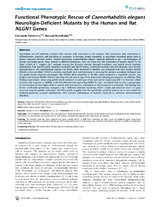Mostrar el registro sencillo del ítem
Functional Phenotypic Rescue of Caenorhabditis elegans Neuroligin-Deficient Mutants by the Human and Rat NLGN1 Genes
| dc.contributor.author | Calahorro, Fernando | |
| dc.contributor.author | Ruiz-Rubio, Manuel | |
| dc.date.accessioned | 2012-12-07T11:49:11Z | |
| dc.date.available | 2012-12-07T11:49:11Z | |
| dc.date.issued | 2012 | |
| dc.identifier.uri | http://hdl.handle.net/10396/8415 | |
| dc.description.abstract | Neuroligins are cell adhesion proteins that interact with neurexins at the synapse. This interaction may contribute to differentiation, plasticity and specificity of synapses. In humans, single mutations in neuroligin encoding genes lead to autism spectrum disorder and/or mental retardation. Caenorhabditis elegans mutants deficient in nlg-1, an orthologue of human neuroligin genes, have defects in different behaviors. Here we show that the expression of human NLGN1 or rat Nlgn1 cDNAs in C. elegans nlg-1 mutants rescues the fructose osmotic strength avoidance and gentle touch response phenotypes. Two specific point mutations in NLGN3 and NLGN4 genes, involved in autistic spectrum disorder, were further characterized in this experimental system. The R451C allele described in NLGN3, was analyzed with both human NLGN1 (R453C) and worm NLG-1 (R437C) proteins, and both were not functional in rescuing the osmotic avoidance behavior and the gentle touch response phenotype. The D396X allele described in NLGN4, which produces a truncated protein, was studied with human NLGN1 (D432X) and they did not rescue any of the behavioral phenotypes analyzed. In addition, RNAi feeding experiments measuring gentle touch response in wild type strain and worms expressing SID-1 in neurons (which increases the response to dsRNA), both fed with bacteria expressing dsRNA for nlg-1, provided evidence for a postsynaptic in vivo function of neuroligins both in muscle cells and neurons, equivalent to that proposed in mammals. This finding was further confirmed generating transgenic nlg-1 deficient mutants expressing NLG-1 under pan-neuronal (nrx-1) or panmuscular (myo-3) specific promoters. All these results suggest that the nematode could be used as an in vivo model for studying particular synaptic mechanisms with proteins orthologues of humans involved in pervasive developmental disorders. | es_ES |
| dc.format.mimetype | application/pdf | es_ES |
| dc.language.iso | eng | es_ES |
| dc.publisher | Public Library of Science (PLOS) | es_ES |
| dc.rights | https://creativecommons.org/licenses/by-nc-nd/4.0/ | es_ES |
| dc.source | PLoS ONE 7 (6), 1-9 (2012) | es_ES |
| dc.subject | NLGN1 Gen | es_ES |
| dc.subject | Caenorhabditis elegans | es_ES |
| dc.subject | Neuroligins | es_ES |
| dc.title | Functional Phenotypic Rescue of Caenorhabditis elegans Neuroligin-Deficient Mutants by the Human and Rat NLGN1 Genes | es_ES |
| dc.type | info:eu-repo/semantics/article | es_ES |
| dc.rights.accessRights | info:eu-repo/semantics/openAccess | es_ES |

